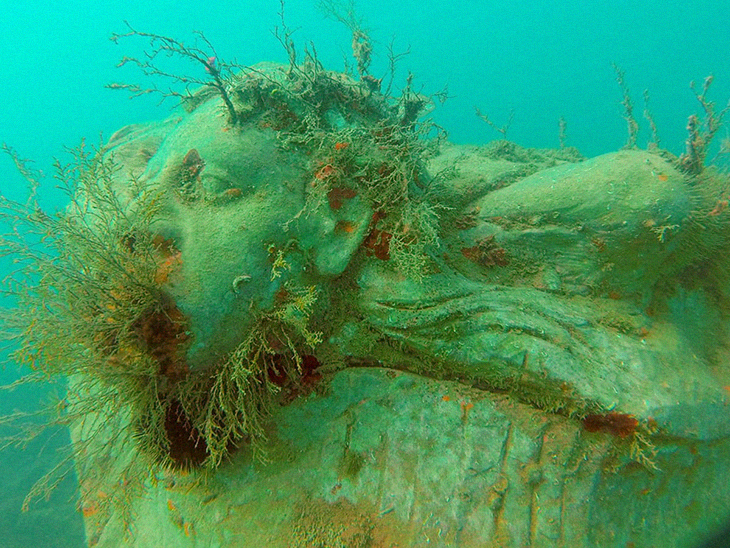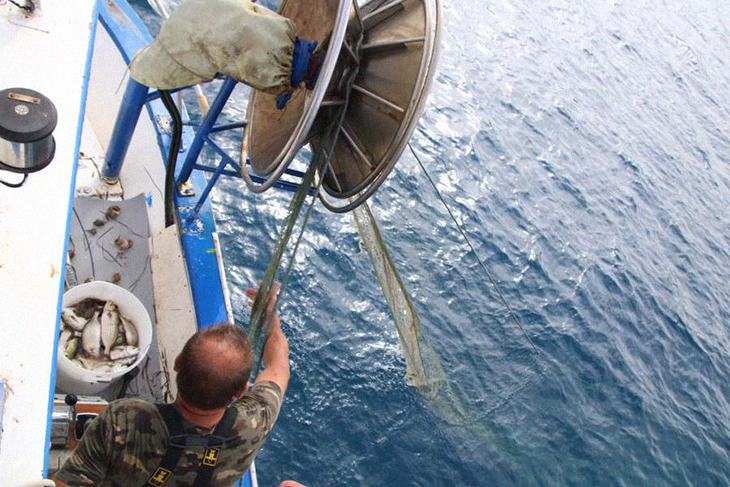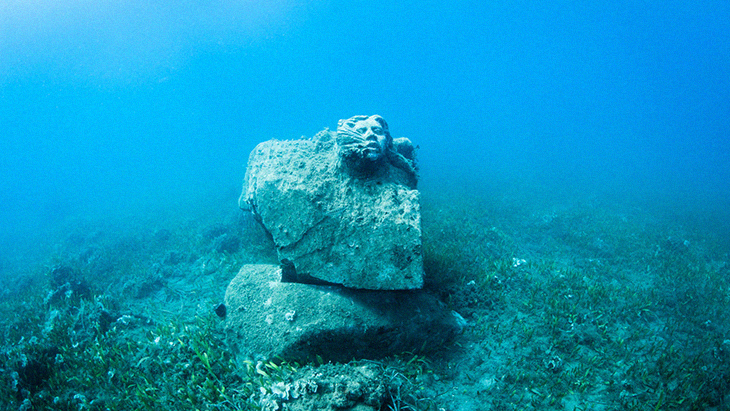There are hundreds of available art mediums and many of these are presented in museums where people can marvel at its beauty. These artists have gained fame and popularity because of their immense talent. Then, there are those everyday folks that surprise you with their ability to create such beauty, especially one for a good cause.
One such Italian fisherman found talent and he used it for a good cause. He What makes these works of arts different is the fact that they aren’t showcased in museums. Rather, they’re found deep underwater. Because of what he did, trawlers have stopped going to the area. Now, people flock to the river to admire what he lovingly created and put together.

Paolo Fanciulli had decided to drop 39 large marble sculptures down to the very bottom of the sea. This can be found off Tuscany’s Maremma Regional Park. He did this for good reason. He had made several attempts in the past to battle unsustainable fishing. While his previous efforts weren’t quite as effective, his first taste of the art world made significant impact.
This is an amazing story, at the heart of which is an equally amazing and charismatic man. This effort is reminiscent of the confluence of an ancient relationship between man and nature, as well as a celebration of the Mediterranean Sea as a symbol of the cradle of civilization.
A 60-year-old fisherman named Fanciulli is a practitioner of sustainable fishing and “pescaturismo” or fishing-tourism at his home. He lives in the village of Talamone. Like anyone in the same industry, he wakes up at the crack of dawn. Then, he heads out into the calm waters off the coast of Tuscany’s Grosseto province. He and his colleague named Francesco fish. They always did what their ancient ancestors did. Instead of employing modern technology, they cast shallow nets that take mullet and bream while leaving the bottom reaches safely unperturbed and untouched.
Fanciulli’s has been fighting against the illegal or unsustainable methods of fishing. This has been documented time and again. In fact, stories about his efforts have appeared in newspapers all around the world. From 2002 to 2006, he commissioned the help of the Tuscan government and WWF-Italia to deploy a strategic formation of 126 underwater cement bollards. These were made to block any form of deep sea trawling nets. The latter have been rapidly destroying the fish stocks that he worked so hard to harvest for.
Fanciulli was aware of how these modern nets would tear up the delicate ecosystem of the seabed. He wanted to protect these seagrass meadows and stop the decapitation of the marine food-web. He was aware of how the nets were extremely expensive to replace, and the relatively-inexpensive bollards, that cost about €560 to make and transport, would last a lot longer than the poachers would.
That work that he did so carefully and meticulously took him twenty years to finish. His story has been narrated in his biography The House of the Fish. He then went on a similar project with interesting differences. He aimed to expand the protection of his beloved Mediterranean waters. This was made possible as he enlisted the help of some of the greatest marble sculptors in the world. His goal was to bring the world’s attention to the wider problem of general environmental degradation.

All about The House of the Fish
Fanciulli talked to GNN about this and said, “The importance of the project is that we need some sensible consumption of resources. However the illegal industry is devastating everything, and with this project we can send a message to the whole world to give back; not only to take.” He further explained, “But the intent of mine is also to think of the future; a better future, with more sustainable fishing, and a greater respect for the environment.”
Paolo Fanciulli went on a tour with some reporters. Along for the ride is his partner, Francesco. He, as they discovered is not just a fisherman, he’s also a philanthropist though he admitted that he has a yet a lot to learn about savvy marketing or social media managing.
So, he got the help of a childhood friend. This said new ally was a successful engineer. Fanciulli talked about his goal as he imagined a series of large marble sculptures, taken from the Carrara Quarry, the fount of a lot of the marble which Michelangelo had used to create his fine pieces of works of art. Fanciulli simply asked for just two pieces, but after meeting with the President of Grosseto region and Ippolito Turco, the president of an association who presently looks after these sculptures decided to give him a hundred.
The question now is who would sculpt them. Fanciulli needed to find generous, philanthropic, and far-sighted sculptors who could put their creativity to good use. These works would serve the sea, but he also needed sufficient funding to transport the 10 to 20 ton blocks from the north of Tuscany all the way to the south.
Then, Fanciulli came upon an artist named Massimo Catalani. He lived in Rome and worked at the famous Federici Palace, Paolo. The fisherman then went to his home and brought the morning’s catch in a large pot for dinner in order to make his point. The artist was well-connected with several important people from the world of art and architecture, and hence, this move could really help. One of whom Catalani was connected to was a woman named Emily Young. Young is considered to be one of Britain’s best living sculptor. Paolo Fanciulli then wrote about the experience and said, “It was like a film.”
The Atlantis of Tuscany
Young was among a dozen international and Italian sculptors. She was one of those who were kind enough to donate their time and effort to contribute to a project that would not be available in traditional museums. While they knew their hard work would slowly become covered in seaweed and seen only by divers as they sit like sentinels on the ocean floor, they wanted to do their part to help protect marine life.
Finally in May 2015, the first 20 stone blocks were placed. Those weren’t considered cheap. In fact, the pieces cost around thousands of dollars. These were then transported to the pier of Talamone. Once there, these loaded onto a barge and floated out until they reached the area where they were going to sit forever. A second group of 19 works were lowered down last summer.
Ippolito Turco talked to The Independent about the whole project and shared, “We’ve managed to totally stop the illegal fishing in the area. Now we’re looking at extending the project along the coast to the north. We want to put more sculptures on the seafloor. It has proved to be very effective.”
Ms. Young also said, “What you want to happen is that in time, you won’t know they are sculptures. They will be so covered in seaweed and algae that they will look like a coral reef or the remains of a wreck.” Young also added how she hopes that they will be discovered by marine archaeologists in the future. By then, these divers could hypothesize that these sculptures could actually be a part of an ancient civilization.
What the Future Looks Like
A total of 61 blocks of greyish marble are still in Turco and Fanciulli’s possession. They are currently waiting for these world-renowned sculptors to carve them into works of art. For those who are knowledgeable about the 17 contrade or guilds of Siena, a sculptor in the team has plans to make one of every animal-symbol on the guilds’ coats of arms. This is now a project that’s bound to attract major investment from the uber-patriotic city. Fanciulli also has plans to work with the people of the Grosseto Cultural Office. He wants them to help install underwater lighting among the sculptures so these are well lit during the night time hours.

“If there are artists that want to come to the House of the Fish, we are available, because the more artists we have the stronger the project,” Fanciulli said to the people of GNN. “I think if famous artists come here, there’s a bigger impact. If there are artists reading this, our sea has need of your talents.”
The La Casa dei Pesci website is one big fundraiser. This is a place where people can go to if they want to contribute in many ways to the project at hand. Here, artists looking to carve a block can post their idea as a fundraising effort. For those who contribute, they also get something in return. They could avail of a free dinner and a fishing trip with Paolo, paintings, and so much more.
What are your thoughts? Please comment below and share this news!
True Activist / Report a typo


